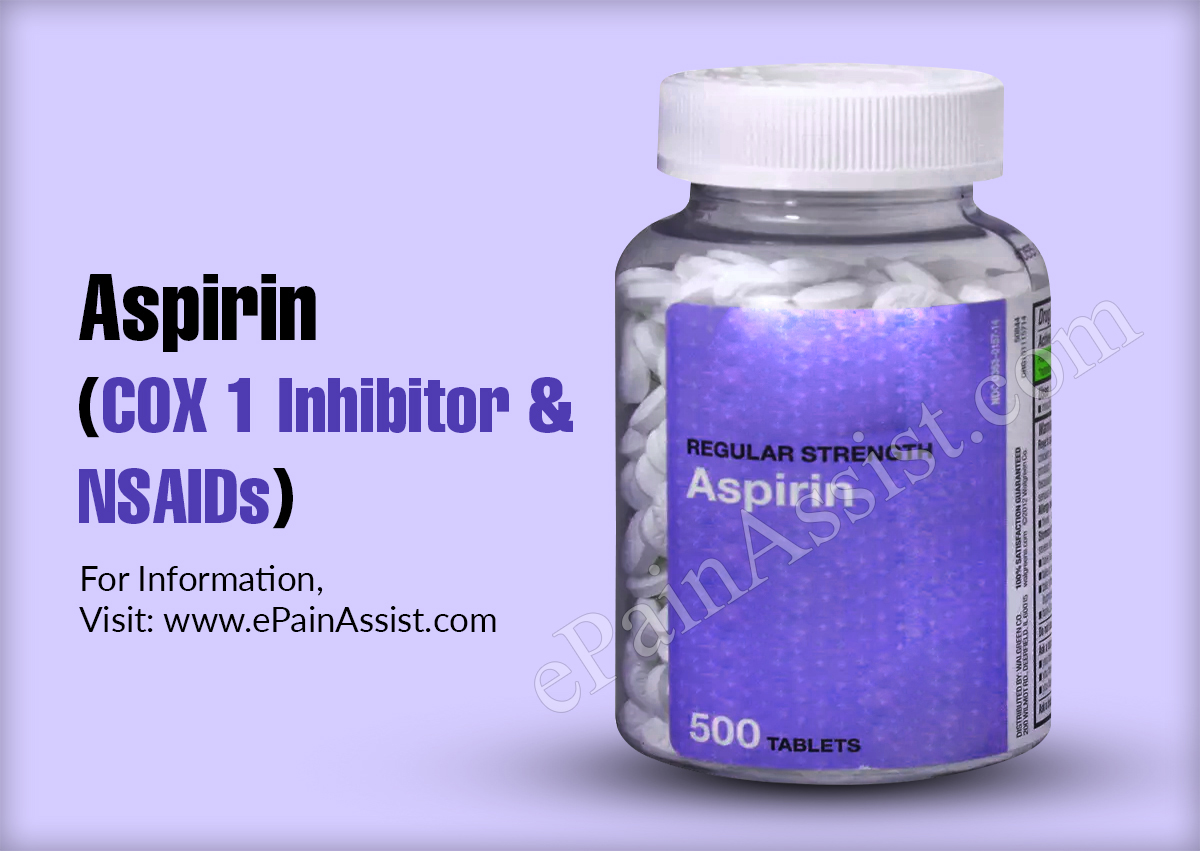About Aspirin
NSAID stands for non-steroidal anti-inflammatory drugs (medication). Tissue inflammation causes increase secretion of cyclooxygenase enzyme. Cyclooxygenase (COX) enzyme stimulates the secretion of prostaglandin, bradykinin, C reacting protein and serotonin by injured epithelial and endothelial cells. These chemical causes inflammatory changes in injured and infected tissue. Prostaglandin and other inflammatory chemicals when secreted in large amount during tissue inflammation also causes fever and pain. NSAID blocks the cyclooxygenase enzyme resulting in decrease secretin of prostaglandin, bradykinin and serotonin. There are two types of cyclooxygenase enzyme known as COX 1 and COX 2. Aspirin inhibits COX 1 enzyme. Aspirin 81 mg is widely used as a preventive medication in patient suffering with coronary vascular disease. Aspirin is also used as an analgesic to treat pain and anti-pyretic medication to treat fever.

-
Alternative Name of Aspirin-
Aspirin is also known as Acetylsalicylic acid (ASA).
-
Mechanism of Action of Aspirin
Aspirin causes reversible inhibition of cyclooxygenase enzyme 1 and 2. Cyclooxygenase enzyme 1 and 2 are also known as COX 1 and COX 2 enzyme. Inhibition of COX 1 and 2 enzyme results in decreased production of prostaglandin and thromboxane (TXA2). Prostaglandin initiates pain impulses when comes in contact with pain receptors and sensory pain fibers.
-
Aspirin is Used For Treatment Of Following Symptoms:
Pain- Aspirin is used as an analgesic to treat mild to moderate pain that is caused by inflammation, joint diseases and injuries.
Fever- Infection and injuries increases prostaglandin levels in blood. Increase prostaglandin resets the temperature to higher level, which follows increased metabolism and fever. Aspirin decreases prostaglandin level in blood and also resets the temperature to normal body temperature at brain center.
Inflammation- Harmful effects caused by infection or trauma to soft tissue, bone and organ induces immune response and inflammation. Inflammatory tissue activates cyclooxygenase enzyme, triggers increase blood flow and activates white blood cells. Cyclooxygenase enzyme stimulates conversion of arachidonic acid to prostaglandin within surrounding tissues. Inflammation and prostaglandin causes irritation of pain receptors and nerve fibers resulting in moderate to severe pain. Aspirin helps to reduce the intensity of inflammatory tissue changes.
-
Use – Aspirin is Used To Treat Following Diseases:
Kawasaki Disease– Kawasaki disease is an inflammatory disease of blood vessels mostly seen in children. The blood vessels affected by inflammation are coronary arteries and blood vessels of extremities. Symptoms of Kawasaki disease is fever, conjunctival redness, ischemic heart disease and death. Aspirin therapy helps to reduce the inflammatory changes of blood vessels.
Pericarditis– Pericarditis is an non-infectious inflammatory disease of pericardium. The inflammation is better treated with aspirin.
Rheumatic Fever- Rheumatic fever is a disease caused by fever and enlarged subcutaneous nodule as well as acute inflammation of heart (carditis), joint (polyarthritis), chorea (vasculitis of basal ganglia). The acute inflammatory rheumatic fever is aggressively treated with aspirin of corticosteroids.
Heart Attack– Heart attack is often caused by blockage or narrowing of coronary arteries. Aspirin helps as a blood thinning medicine and prevent blood clot formation that helps to prevent second heart attack.
Colorectal Cancer- Published data suggest less number of colorectal cancer is observed in population taking aspirin.
-
Contraindication- Aspirin Is Avoided In Following Condition
Pregnancy- Aspirin causes premature early closure of patent ductus arteriosus in infant if taken during third trimester. Aspirin may cause brain hemorrhage in premature infant if mother is taking aspirin during third trimester.
Blood thinning medicine- Avoid taking while on other blood thinning medications;
Rye syndrome- Previous history of Rye syndrome (progressive encephalopathy). The symptoms of Rye syndrome is confusion, seizure, vomiting and loss of consciousness.
-
Dosage of Aspirin
Aspirin is available on the shelf and strength of pills are 81 mg (baby aspirin), 325 mg and 650 mg. Baby aspirin 81 mg is used for prevention of heart attack (coronary artery disease) in patient suffering with coronary artery disease.
Dosage in adults is 375 to 500 mg aspirin 4 times a day. Dosage for children suffering with diseases like Kawasaki Disease is 5 mg / kg. 3 to 4 times a day.
-
Side Effects Caused by Aspirin
- Gastritis;
- Stomach Ulcer and bleeding stomach;
- Gastrointestinal bleeding;
- Tinnitus (ringing in the ear) caused by large concentration of metabolite of aspirin known as salicylate;
- Reye’s syndrome- rarely few children suffer with symptoms of acute encephalopathy and fatty liver following treatment of aspirin;
- Skin allergy results in hives, swelling and headache;
Also Read:
- What Are NSAIDs? Know The Risk Factors, Side Effects, Complications, Classifications, Symptoms and Treatment Indication
- NSAIDS: A Cause For Peptic Ulcer Disease!
- What are NSAIDS, Know its Mechanism of Action, Medical Conditions It Can Treat
- Best NSAIDs or Nonsteroidal Antiinflammatory Drugs for Pain Relief?
Reference
-
Aspirin for the prevention of colorectal cancer
X. Garcia-Albeniz, MD, Research Fellowa and A.T. Chan, MD, MPH, Assistant Professor of Medicineb,* Best Pract Res Clin Gastroenterol. 2011 Aug; 25(0): 461–472.
-
Aspirin and Reye syndrome: a review of the evidence.
Schrör K1., Paediatr Drugs. 2007;9(3):195-204.
